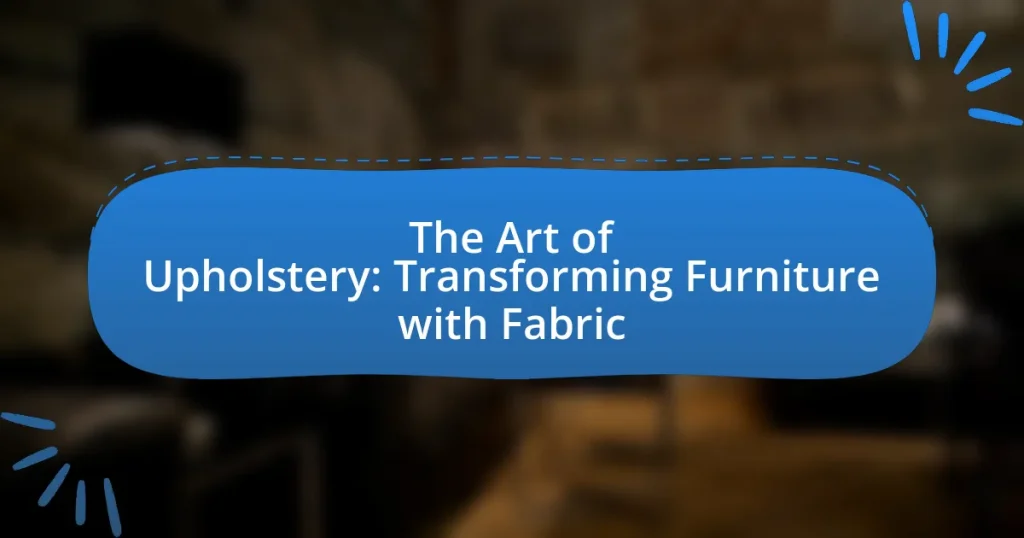The Art of Upholstery is a skilled practice focused on covering furniture with fabric, padding, and other materials to enhance both aesthetics and comfort. This article explores the transformative effects of upholstery on furniture, detailing common techniques such as stapling, tacking, sewing, and tufting, as well as the significance of fabric choice. It also examines the historical origins and evolution of upholstery, its classification into various styles, and the essential skills required for successful upholsterers. Additionally, the article highlights the environmental benefits of upholstery, including sustainability through reupholstering and the use of eco-friendly fabrics, while providing practical tips for selecting materials and avoiding common mistakes in upholstery projects.

What is the Art of Upholstery?
The Art of Upholstery is the skilled practice of covering furniture with fabric, padding, and other materials to enhance its aesthetic appeal and comfort. This craft involves techniques such as frame construction, fabric selection, and the application of various upholstery methods, which have evolved over centuries. Historically, upholstery has roots in ancient civilizations, where it was used to create luxurious seating for the elite, showcasing the importance of craftsmanship and design in furniture making.
How does upholstery transform furniture?
Upholstery transforms furniture by enhancing its aesthetic appeal, comfort, and functionality. Through the application of various fabrics, padding, and techniques, upholstery can rejuvenate old or worn-out pieces, making them visually appealing and more comfortable for use. For instance, a study by the Furniture Industry Research Association highlights that reupholstered furniture can increase the perceived value of a piece by up to 50%, demonstrating the significant impact of upholstery on both appearance and marketability.
What techniques are commonly used in upholstery?
Common techniques used in upholstery include stapling, tacking, sewing, and tufting. Stapling is often employed to secure fabric to the frame of furniture, providing a quick and efficient method for attachment. Tacking involves using nails or tacks to hold the fabric in place, which can add decorative elements as well. Sewing is crucial for creating seams and ensuring that fabric pieces fit together seamlessly, while tufting is a technique that creates a padded effect by pulling the fabric tight and securing it at intervals, often enhancing the aesthetic appeal of upholstered items. These techniques are foundational in the upholstery process, ensuring durability and visual appeal in finished furniture.
How does fabric choice impact the upholstery process?
Fabric choice significantly impacts the upholstery process by influencing durability, aesthetics, and ease of application. Different fabrics have varying levels of strength, wear resistance, and maintenance requirements, which directly affect the longevity of the upholstered piece. For instance, synthetic fabrics like polyester are often more durable and stain-resistant compared to natural fabrics like cotton, making them suitable for high-traffic areas. Additionally, the texture and pattern of the fabric can alter the visual appeal of the furniture, guiding design decisions and customer preferences. The upholstery process itself may also vary; thicker fabrics may require more specialized tools and techniques for proper application, while lighter fabrics can be easier to work with but may not provide the same level of durability.
Why is upholstery considered an art form?
Upholstery is considered an art form because it combines creativity, craftsmanship, and design to transform furniture into functional and aesthetically pleasing pieces. The process involves selecting materials, colors, and patterns that enhance the overall look while ensuring comfort and durability. Historical evidence shows that upholstery has evolved from simple fabric coverings to intricate designs that reflect cultural and artistic movements, such as the Rococo style in the 18th century, which emphasized ornate details and luxurious fabrics. This blend of technical skill and artistic expression solidifies upholstery’s status as an art form.
What skills are essential for a successful upholsterer?
Essential skills for a successful upholsterer include sewing proficiency, attention to detail, and knowledge of materials. Sewing proficiency allows upholsterers to create precise seams and finishes, which is critical for quality craftsmanship. Attention to detail ensures that patterns align correctly and that the final product meets aesthetic and functional standards. Knowledge of materials, including fabrics and foams, enables upholsterers to select the right components for durability and comfort. These skills collectively contribute to the overall success and quality of upholstery work.
How does creativity play a role in upholstery design?
Creativity is essential in upholstery design as it allows designers to innovate and personalize furniture, enhancing both aesthetics and functionality. This innovation manifests through the selection of unique fabrics, patterns, and textures that reflect current trends and individual tastes. For instance, a study by the Textile Institute highlights that creative upholstery can significantly increase the perceived value of furniture, demonstrating that imaginative design choices can elevate a simple piece into a statement item. Additionally, creativity enables the integration of ergonomic principles, ensuring that the furniture is not only visually appealing but also comfortable and practical for everyday use.
What are the historical origins of upholstery?
Upholstery originated in ancient civilizations, primarily in Egypt, where furniture was adorned with textiles for comfort and aesthetics. The practice evolved through the Middle Ages in Europe, where wealthy households began using padded and covered furniture to display status and luxury. By the 17th century, upholstery techniques advanced significantly, incorporating springs and more elaborate fabrics, reflecting the growing importance of comfort and design in furniture. Historical records indicate that the term “upholstery” itself emerged in the late 14th century, derived from the Old French word “upholster,” which referred to the act of covering furniture with fabric.
How has upholstery evolved over the centuries?
Upholstery has evolved significantly over the centuries, transitioning from simple, functional coverings to intricate designs that enhance both comfort and aesthetics. In ancient times, upholstery primarily involved animal hides and natural fibers, serving basic protective and functional purposes. By the Middle Ages, the introduction of textiles like wool and silk allowed for more decorative and luxurious applications, reflecting social status. The 18th century saw the rise of elaborate upholstery techniques, including tufting and the use of springs, which improved comfort and durability. The Industrial Revolution further transformed upholstery with mass production techniques, making upholstered furniture more accessible to the general public. Today, upholstery incorporates advanced materials and technologies, such as synthetic fabrics and eco-friendly options, while still honoring traditional craftsmanship. This historical progression illustrates how upholstery has adapted to cultural shifts, technological advancements, and changing consumer preferences.
What cultural influences have shaped upholstery styles?
Upholstery styles have been shaped by various cultural influences, including historical events, regional materials, and artistic movements. For instance, the Renaissance period in Europe introduced intricate patterns and rich fabrics, reflecting the era’s emphasis on artistry and craftsmanship. Additionally, Asian cultures, particularly Chinese and Japanese, have influenced upholstery through the use of silk and minimalist designs, emphasizing harmony and nature. The Arts and Crafts movement in the late 19th century promoted handcrafted textiles and natural materials, responding to industrialization. These cultural influences demonstrate how upholstery styles evolve by integrating diverse artistic expressions and material practices from different societies.
How can one get started in upholstery?
To get started in upholstery, one should begin by acquiring basic tools and materials, such as a staple gun, fabric, foam, and upholstery needles. Learning fundamental techniques through online tutorials or local workshops is essential, as these resources provide practical skills and knowledge about different upholstery styles and methods. Additionally, practicing on small projects, like reupholstering a chair, allows for hands-on experience, which is crucial for mastering the craft. Engaging with upholstery communities, either online or in-person, can also offer valuable insights and support.
What tools and materials are necessary for upholstery projects?
Upholstery projects require specific tools and materials to ensure successful completion. Essential tools include a staple gun, upholstery needles, scissors, and a hammer, which are used for attaching fabric and securing components. Materials necessary for these projects consist of upholstery fabric, foam padding, batting, and webbing, which provide comfort and aesthetic appeal. The combination of these tools and materials is critical, as they facilitate the transformation of furniture by allowing for precise application and durable results.
What types of fabrics are best suited for upholstery?
The best types of fabrics for upholstery include cotton, linen, polyester, leather, and microfiber. Cotton is durable and easy to clean, making it a popular choice for various furniture styles. Linen offers a natural look and breathability but may wrinkle easily. Polyester is known for its resistance to stains and fading, providing longevity in upholstery applications. Leather adds a luxurious feel and is highly durable, while microfiber is soft, stain-resistant, and easy to maintain. These fabrics are commonly used in upholstery due to their balance of aesthetics, durability, and ease of care.
How do different tools affect the upholstery process?
Different tools significantly impact the upholstery process by enhancing efficiency, precision, and quality of the finished product. For instance, specialized tools like staple guns allow for quicker attachment of fabric to frames, reducing labor time and ensuring a secure fit. Additionally, cutting tools such as rotary cutters provide cleaner edges, which contribute to a more professional appearance. The use of sewing machines designed for upholstery can also improve stitch quality and speed, allowing for more intricate designs and stronger seams. Overall, the right tools streamline the upholstery process, leading to better craftsmanship and durability in the final furniture piece.

What are the different styles of upholstery?
The different styles of upholstery include traditional, contemporary, modern, vintage, and eclectic. Traditional upholstery often features classic patterns and rich fabrics, reflecting historical design elements. Contemporary upholstery emphasizes clean lines and minimalism, utilizing modern materials and colors. Modern upholstery incorporates innovative techniques and bold designs, often focusing on functionality. Vintage upholstery revives styles from past decades, showcasing unique fabrics and patterns that evoke nostalgia. Eclectic upholstery combines various styles and influences, allowing for personalized and creative expressions in furniture design. Each style serves distinct aesthetic preferences and functional needs in interior design.
How do traditional and modern upholstery styles differ?
Traditional upholstery styles emphasize ornate designs, rich fabrics, and intricate craftsmanship, often featuring patterns like florals and damasks. In contrast, modern upholstery styles prioritize minimalism, clean lines, and functionality, utilizing materials such as leather and synthetic fabrics with solid colors or geometric patterns. The historical context shows that traditional upholstery dates back to the 18th and 19th centuries, reflecting the craftsmanship of that era, while modern upholstery emerged in the 20th century, influenced by movements like Bauhaus that favored simplicity and practicality.
What are the characteristics of classic upholstery styles?
Classic upholstery styles are characterized by their emphasis on traditional craftsmanship, rich fabrics, and timeless designs. These styles often feature ornate details such as tufting, nailhead trim, and intricate patterns, reflecting historical influences from various periods like Victorian, Georgian, and Louis XVI. The use of high-quality materials, including velvet, brocade, and leather, is common, ensuring durability and a luxurious appearance. Additionally, classic upholstery typically incorporates a structured silhouette, with furniture pieces designed to convey elegance and sophistication, aligning with the aesthetic values of their respective eras.
How do contemporary trends influence upholstery design?
Contemporary trends significantly influence upholstery design by prioritizing sustainability, minimalism, and multifunctionality. Designers increasingly select eco-friendly materials, such as organic fabrics and recycled components, reflecting a growing consumer demand for environmentally responsible choices. For instance, the Global Sustainability Study by Nielsen reported that 73% of millennials are willing to pay more for sustainable products, which drives upholstery manufacturers to adopt greener practices. Additionally, the minimalist aesthetic, characterized by clean lines and neutral colors, has gained popularity, leading to designs that emphasize simplicity and functionality. This trend is supported by the rise of urban living spaces, where multifunctional furniture is essential. As a result, upholstery design is evolving to meet these contemporary demands, integrating both style and practicality.
What role does color play in upholstery?
Color plays a crucial role in upholstery by influencing aesthetics, mood, and the overall perception of space. The choice of color can enhance the visual appeal of furniture, create a desired atmosphere, and even affect the emotional response of individuals within a room. For instance, warm colors like reds and oranges can evoke feelings of warmth and energy, while cool colors such as blues and greens promote calmness and relaxation. Studies in color psychology support these effects, indicating that color can significantly impact human emotions and behaviors, thus validating the importance of color selection in upholstery design.
How can color choices affect the mood of a space?
Color choices significantly affect the mood of a space by influencing emotions and perceptions. For instance, warm colors like red and orange can evoke feelings of warmth and energy, while cool colors such as blue and green tend to create a calming and serene atmosphere. Research from the Journal of Environmental Psychology indicates that color can impact mood and behavior, with specific colors linked to particular emotional responses. For example, studies show that yellow can stimulate feelings of happiness and optimism, while darker colors may induce feelings of sadness or heaviness. Thus, selecting appropriate colors in upholstery and decor can effectively transform the emotional landscape of a room.
What are the best practices for selecting upholstery colors?
The best practices for selecting upholstery colors include considering the overall color scheme of the room, understanding the psychological effects of colors, and evaluating the fabric’s durability and maintenance requirements. A cohesive color palette enhances the aesthetic appeal, while colors like blue and green can create calming environments, as supported by color psychology studies. Additionally, selecting colors that complement existing furnishings and ensuring they are practical for the intended use, such as stain resistance for high-traffic areas, further validates the choice of upholstery colors.
What are common upholstery techniques and methods?
Common upholstery techniques and methods include stapling, tacking, sewing, and using adhesives. Stapling is widely used for securing fabric to frames, providing a strong hold. Tacking involves using nails or tacks to attach fabric, often seen in traditional upholstery. Sewing is essential for creating seams and attaching various components, ensuring durability and a polished finish. Adhesives are increasingly popular for quick applications and can bond fabric to surfaces effectively. These methods are foundational in upholstery, allowing for both functional and aesthetic transformations of furniture.
How does the process of reupholstering differ from new upholstery?
Reupholstering involves replacing the fabric and padding on existing furniture, while new upholstery entails creating a completely new piece of furniture from scratch. In reupholstering, the original frame and structure are retained, which can save time and resources, whereas new upholstery requires the construction of a frame, selection of materials, and assembly of the entire piece. This distinction highlights that reupholstering is often a more sustainable option, as it extends the life of existing furniture, while new upholstery offers the opportunity for customization and design from the ground up.
What are the steps involved in the upholstery process?
The upholstery process involves several key steps: stripping, repairing, padding, covering, and finishing. First, stripping entails removing the old fabric and padding from the furniture to expose the frame. Next, repairing involves fixing any structural issues with the frame or springs to ensure durability. Padding follows, where new cushioning materials are added for comfort and shape. The covering step includes applying the new fabric, which is carefully stretched and secured to the frame. Finally, finishing involves adding any necessary details, such as trim or buttons, to complete the look. Each step is crucial for achieving a high-quality upholstery result, ensuring both aesthetics and functionality.

What are the benefits of upholstery?
Upholstery provides several benefits, including enhanced comfort, aesthetic appeal, and increased furniture longevity. Comfort is improved through the use of high-quality padding and fabric, which can transform a hard surface into a cozy seating area. Aesthetic appeal is achieved by allowing customization in fabric choice, color, and design, enabling furniture to match personal style and home decor. Additionally, upholstery can extend the life of furniture by protecting it from wear and tear, as well as allowing for repairs and updates, which is supported by the fact that well-maintained upholstered furniture can last for decades.
How does upholstery enhance furniture longevity?
Upholstery enhances furniture longevity by providing a protective layer that shields the underlying materials from wear and tear. This protective layer prevents damage from daily use, such as scratches, stains, and fading, which can significantly reduce the lifespan of furniture. Additionally, high-quality upholstery materials, such as durable fabrics and foams, are designed to withstand stress and maintain their shape over time, further contributing to the durability of the furniture. Studies have shown that well-upholstered furniture can last several years longer than poorly upholstered pieces, demonstrating the importance of quality upholstery in extending the life of furniture.
What impact does upholstery have on furniture comfort?
Upholstery significantly impacts furniture comfort by providing cushioning, support, and a tailored fit to the body. The choice of materials, such as foam density and fabric type, directly influences how comfortable a piece of furniture feels during use. For instance, high-density foam offers better support and durability, while softer fabrics can enhance the overall tactile experience. Studies have shown that well-upholstered furniture can reduce pressure points and improve posture, leading to a more enjoyable sitting experience.
How can upholstery increase the aesthetic value of furniture?
Upholstery increases the aesthetic value of furniture by enhancing its visual appeal through the use of color, texture, and patterns. The choice of fabric can dramatically alter the perception of a piece, making it more inviting and stylish. For instance, high-quality upholstery materials like velvet or leather can convey luxury, while vibrant patterns can add a playful or contemporary touch. Additionally, upholstery can be tailored to complement existing decor, creating a cohesive look in a space. Studies show that well-upholstered furniture can increase a room’s overall attractiveness, making it a focal point and elevating the interior design.
What are the environmental benefits of upholstery?
Upholstery offers significant environmental benefits by promoting sustainability through the reuse and recycling of materials. By reupholstering furniture instead of discarding it, valuable resources are conserved, reducing waste in landfills. Additionally, many upholstery fabrics are made from recycled materials, which further decreases the demand for new raw materials and lowers carbon emissions associated with production. For instance, using recycled polyester can save up to 75% of the energy required to produce virgin polyester. Furthermore, upholstery can extend the lifespan of furniture, minimizing the need for new manufacturing and the associated environmental impact.
How does reupholstering contribute to sustainability?
Reupholstering contributes to sustainability by extending the life of furniture and reducing waste. When furniture is reupholstered, it prevents the need for new materials and minimizes the environmental impact associated with manufacturing and disposing of new items. According to the Environmental Protection Agency, furniture accounts for a significant portion of landfill waste, and reupholstering helps mitigate this by keeping existing pieces in use. Additionally, reupholstering often utilizes eco-friendly fabrics and materials, further enhancing its sustainability benefits.
What are eco-friendly fabric options available for upholstery?
Eco-friendly fabric options available for upholstery include organic cotton, linen, hemp, and recycled polyester. Organic cotton is grown without synthetic pesticides or fertilizers, making it a sustainable choice. Linen, derived from the flax plant, requires less water and pesticides compared to conventional fabrics. Hemp is known for its durability and low environmental impact, as it grows quickly and requires minimal resources. Recycled polyester, made from post-consumer plastic bottles, helps reduce waste and conserves resources. These fabrics not only minimize environmental harm but also offer a range of aesthetic and functional benefits for upholstery.
What are some tips for successful upholstery projects?
To achieve successful upholstery projects, it is essential to plan meticulously, select high-quality materials, and utilize proper techniques. Planning involves measuring the furniture accurately and determining the amount of fabric needed, which ensures a precise fit and reduces waste. Choosing high-quality materials, such as durable fabrics and strong padding, enhances the longevity and appearance of the finished piece. Employing proper techniques, including using a staple gun effectively and ensuring tight, even seams, contributes to a professional-looking result. These practices are supported by industry standards that emphasize the importance of preparation and material selection in upholstery work.
How can one choose the right fabric for their upholstery project?
To choose the right fabric for an upholstery project, one should consider durability, texture, and maintenance requirements. Fabrics like cotton and linen are breathable and suitable for low-traffic areas, while synthetic options like polyester and nylon offer higher durability for high-traffic spaces. Additionally, the fabric’s pattern and color should complement the existing decor. According to the Upholstery Fabric Guide by the American Home Furnishings Alliance, selecting a fabric with a higher rub count indicates better durability, making it a crucial factor in the decision-making process.
What are common mistakes to avoid in upholstery?
Common mistakes to avoid in upholstery include inadequate preparation, poor fabric selection, and improper measuring. Inadequate preparation can lead to uneven surfaces and poor adhesion, while poor fabric selection may result in a mismatch between durability and aesthetic appeal. Improper measuring often causes fabric shortages or excess, leading to wasted materials and increased costs. According to upholstery experts, these mistakes can significantly impact the quality and longevity of the finished product, emphasizing the importance of careful planning and execution in upholstery projects.


